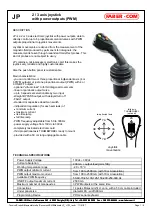
27
RICS
Diagnostics
5
Diagnostics
5.1
RICS Diagnostic functions
In RICS you can distinguish three types of alarm, based on the origin of the alarm signal:
•
Local device alarms.
•
RICS generated alarms, after the comparison of the magnitudes measured compared to threshold levels or reference
conditions.
•
Lack of connection alarms. These are also generated by RICS, and can indicate that the device is turned off, or
broken, or that the connection has simply been interrupted.
The alarm status is displayed on the screen, recorded in the database and a communication is sent by e-mail, fax or SMS
Text Messages Text Messages.
Moreover, an alarm condition may lead to a relay being turned on, if a hardware module has been connected to RICS that
is suitable for the purpose, such as module IFC29.
5.1.1
Local device alarms
The devices connected to RICS, that are based on microprocessors, can be simple data collection modules or complete
electronic control systems (thermostats, cold-room control systems, for temperature reducers or ovens, dedicated appli-
cations, etc…).
Generally, even the simpler devices can control the correct connection of sensors and their functionality. If the device has
a display, buzzer or alarm LED, the error condition is shown directly by the device.
If the device is not a simple sensor or data collector, but a more complex device, it may have very evolved internal
diagnostics that can advise users regarding tens of distinct anomalous conditions, managed through delays, reference
thresholds, inhibitions based on the machine status etc… The control systems manage the anomalous situations locally
with the correct behaviour.
“Intelligence”, in this case, is shared. Some examples:
•
Antifreeze alarm: the value shown by a sensor is monitored and if the temperature drops below the given threshold,
the control system activates a buzzer, or an alarm relay, and also turns on the antifreeze circuit. If the conditions
persist or worsen then the control system blocks the output.
•
Manostat alarm: A digital contact reads the existence of excessive pressure in a manostat. The control system turns
the compressor off until the alarm conditions return to normal.
•
Open door alarm: the device control system gives an acoustic warning if the door is open and if it is not closed within
a certain pre-established lapse of time.
RICS can read the status of local device alarms, and store their status on the computer, send warnings, etc…
RICS answers local device alarms with delays, inhibitions and warnings.
For example you can set RICS to warn about the Open door alarm on a device with an e-mail 1 hour after the
alarm itself has been activated.
This allows staff to close the door, after having heard the acoustic alarm, before sending a useless warning to the alarm
control service.
Note that the inhibition of a local device alarm on RICS does not mean that the alarm is not taken into consideration: in
fact it will appear anyway on the physical display device indicating the plant that has an alarm condition.
[ RICS ]
Diagnostics
Summary of Contents for RICS 4.30
Page 1: ......
Page 2: ......
Page 3: ...RICS 4 30 WHAT IS NEW COMPAREDWITH RICS 4 21...
Page 11: ......
Page 19: ......
Page 20: ......
Page 22: ......
Page 26: ......
Page 28: ......
Page 32: ......
Page 48: ......
Page 64: ......
Page 74: ......
Page 82: ...70 RICS Device configuration page Screenshot 11 7 Device configuration page Web sub page...
Page 86: ......
Page 100: ......
Page 101: ......
Page 103: ......
Page 104: ......
















































